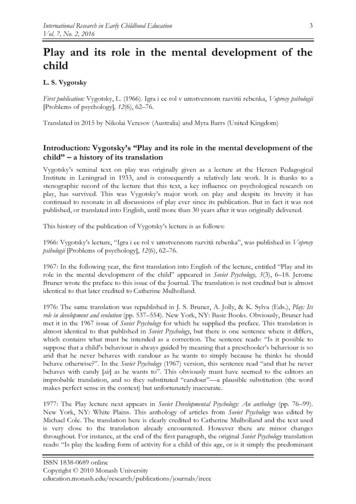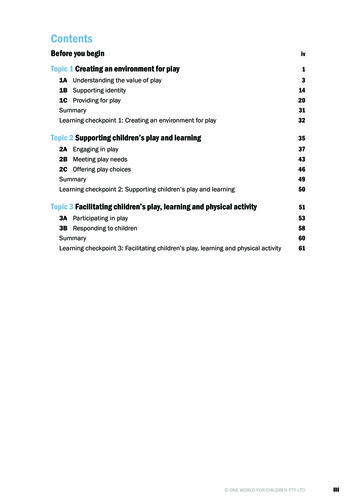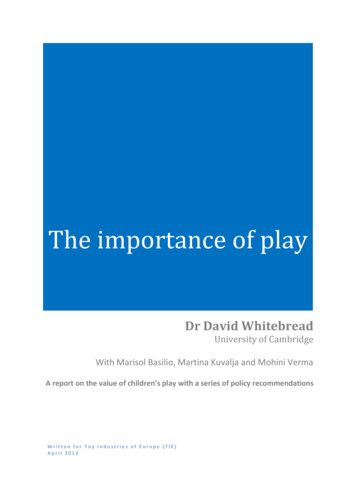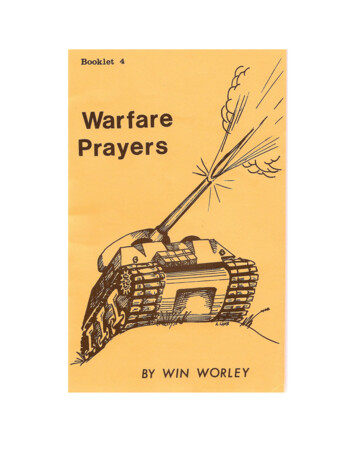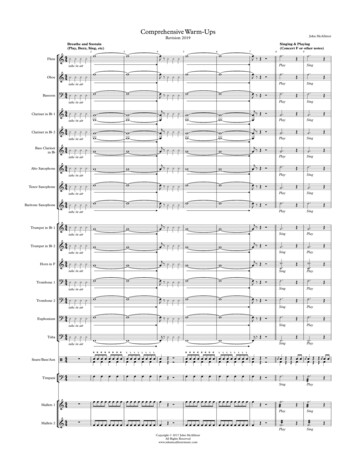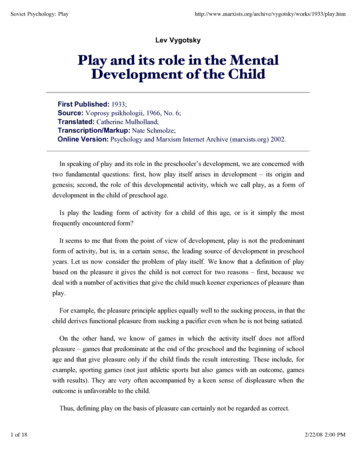
Transcription
Soviet Psychology: /1933/play.htmLev VygotskyPlay and its role in the MentalDevelopment of the ChildFirst Published: 1933;Source: Voprosy psikhologii, 1966, No. 6;Translated: Catherine Mulholland;Transcription/Markup: Nate Schmolze;Online Version: Psychology and Marxism Internet Archive (marxists.org) 2002.In speaking of play and its role in the preschooler’s development, we are concerned withtwo fundamental questions: first, how play itself arises in development – its origin andgenesis; second, the role of this developmental activity, which we call play, as a form ofdevelopment in the child of preschool age.Is play the leading form of activity for a child of this age, or is it simply the mostfrequently encountered form?It seems to me that from the point of view of development, play is not the predominantform of activity, but is, in a certain sense, the leading source of development in preschoolyears. Let us now consider the problem of play itself. We know that a definition of playbased on the pleasure it gives the child is not correct for two reasons – first, because wedeal with a number of activities that give the child much keener experiences of pleasure thanplay.For example, the pleasure principle applies equally well to the sucking process, in that thechild derives functional pleasure from sucking a pacifier even when he is not being satiated.On the other hand, we know of games in which the activity itself does not affordpleasure – games that predominate at the end of the preschool and the beginning of schoolage and that give pleasure only if the child finds the result interesting. These include, forexample, sporting games (not just athletic sports but also games with an outcome, gameswith results). They are very often accompanied by a keen sense of displeasure when theoutcome is unfavorable to the child.Thus, defining play on the basis of pleasure can certainly not be regarded as correct.1 of 182/22/08 2:00 PM
Soviet Psychology: /1933/play.htmNonetheless, it seems to me that to refuse to approach the problem of play from thestandpoint of fulfillment of the child’s needs, his incentives to act, and his affectiveaspirations would result in a terrible intellectualization of play. The trouble with a number oftheories of play lies in their tendency to intellectualize the problem.I am inclined to give an even more general meaning to the problem; and I think that themistake of many accepted theories is their disregard of the child’s needs – taken in thebroadest sense, from inclinations to interests, as needs of an intellectual nature – or, morebriefly, disregard of everything that can come under the category of incentives and motivesfor action. We often describe a child’s development as the development of his intellectualfunctions, i.e., every child stands before us as a theoretical being who, according to thehigher or lower level of his intellectual development, moves from one age period to another.Without a consideration of the child’s needs, inclinations, incentives, and motives to act –as research has demonstrated – there will never be any advance from one stage to the next. Ithink that an analysis of play should start with an examination of these particular aspects.It seems that every advance from one age period to another is connected with an abruptchange in motives and incentives to act.What is of the greatest interest to the infant has almost ceased to interest the toddler. Thismaturing of new needs and new motives for action is, of course, the dominant factor,especially as it is impossible to ignore the fact that a child satisfies certain needs andincentives in play; and without understanding the special nature of these incentives, wecannot imagine the uniqueness of that type of activity we call play.At preschool age special needs and incentives arise that are very important for the wholeof the child’s development and that are spontaneously expressed in play. In essence, therearise in a child of this age many unrealizable tendencies and immediately unrealizabledesires. A very young child tends to gratify his desires at once. Any delay in fulfilling themis hard for him and is acceptable only within certain narrow limits; no one has met a childunder three who wanted to do something a few days hence. Ordinarily, the interval betweenthe motive and its realization is extremely short. I think that if there were no development inpreschool years of needs that cannot be realized immediately, there would be no play.Experiments show that the development of play is arrested both in intellectuallyunderdeveloped children and in those who are affectively immature.From the viewpoint of the affective sphere, it seems to me that play is invented at the2 of 182/22/08 2:00 PM
Soviet Psychology: /1933/play.htmpoint when unrealizable tendencies appear in development. This is the way a very youngchild behaves: he wants a thing and must have it at once. If he cannot have it, either hethrows a temper tantrum, lies on the floor and kicks his legs, or he is refused, pacified, anddoes not get it.His unsatisfied desires have their own particular modes of substitution, rejection, etc.Toward the beginning of pre-school age, unsatisfied desires and tendencies that cannot berealized immediately make their appearance, while the tendency to immediate fulfillment ofdesires, characteristic of the preceding stage, is retained. For example, the child wants to bein his mother’s place, or wants to be a rider on a horse. This desire cannot be fulfilled rightnow. What does the very young child do if he sees a passing cab and wants to ride in it nomatter what may happen? If he is a spoiled and capricious child, he will demand that hismother put him in the cab at any cost, or he may throw himself on the ground right there inthe street, etc. If he is an obedient child, used to renouncing his desires, he will turn away,or his mother will offer him some candy, or simply distract him with some stronger affect,and he will renounce his immediate desire.In contrast to this, a child over three will show his own particular conflicting tendencies;on the one hand, many long-lasting needs and desires will appear that cannot be met at oncebut that nevertheless are not passed over like whims; on the other hand, the tendencytoward immediate realization of desires is almost completely retained.Henceforth play is such that the explanation for it must always be that it is the imaginary,illusory realization of unrealizable desires. Imagination is a new formation that is notpresent in the consciousness of the very young child, is totally absent in animals, andrepresents a specifically human form of conscious activity. Like all functions ofconsciousness, it originally arises from action. The old adage that children’s play isimagination in action can be reversed: we can say that imagination in adolescents andschoolchildren is play without action.It is difficult to imagine that an incentive compelling a child to play is really just the samekind of affective incentive as sucking a pacifier is for an infant.It is hard to accept that pleasure derived from preschool play is conditioned by the sameaffective mechanism as simple sucking of a pacifier. This simply does not fit our notions ofpreschool development.All of this is not to say that play occurs as the result of each and every unsatisfied desire:3 of 182/22/08 2:00 PM
Soviet Psychology: /1933/play.htma child wants to ride in a cab, the wish is not immediately gratified, so the child goes intohis room and begins to play cabs. It never happens just this way. Here we are concernedwith the fact that the child has not only individual, affective reactions to separate phenomenabut generalized, unpredesignated, affective tendencies. Let us take the example of amicroencephalic child suffering from an acute inferiority complex: he is unable to participatein children’s groups; he has been so teased that he smashes every mirror and pane of glassshowing his reflection. But when he was very young, it had been very different; then, everytime he was teased there was a separate affective reaction for each separate occasion, whichhad not yet become generalized. At preschool age the child generalizes his affective relationto the phenomenon regardless of the actual concrete situation because the affective relationis connected with the meaning of the phenomenon in that it continually reveals hisinferiority complex.Play is essentially wish fulfillment – not, however, isolated wishes, but generalizedaffects. A child at this age is conscious of his relationships with adults, and reacts to themaffectively; unlike in early childhood, he now generalizes these affective reactions (herespects adult authority in general, etc.).The presence of such generalized affects in play does not mean that the child himselfunderstands the motives that give rise to a game or that he does it consciously. He playswithout realizing the motives of the play activity. In this, play differs substantially fromwork and other forms of activity. On the whole it can be said that motives, actions, andincentives belong to a more abstract sphere and become accessible to consciousness only atthe transitional age. Only an adolescent can clearly determine for himself the reason he doesthis or that.We shall leave the problem of the affective aspect for the moment – considering it asgiven – and shall now examine the development of play activity itself.I think that in finding criteria for distinguishing a child’s play activity from his othergeneral forms of activity it must be accepted that in play a child creates an imaginarysituation. This is possible on the basis of the separation of the fields of vision and meaningthat occurs in the preschool period.This is not a new idea, in the sense that imaginary situations in play have always beenrecognized; but they have always been regarded as one of the groups of play activities.Thus the imaginary situation has always been classified as a secondary symptom. In theview of earlier writers, the imaginary situation was not the criterial attribute of play in4 of 182/22/08 2:00 PM
Soviet Psychology: /1933/play.htmgeneral, but only an attribute of a given group of play activities.I find three main flaws in this argument. First, there is the danger of an intellectualisticapproach to play. If play is to be understood as symbolic, there is the danger that it may turninto a kind of activity akin to algebra in action; it may be transformed into a system of signsgeneralizing actual reality. Here we find nothing specific in play, and look upon the child asan unsuccessful algebraist who cannot yet write the symbols on paper, but depicts them inaction. It is essential to show the connection with incentives in play, since play itself, in myview, is never symbolic action, in the proper sense of the term.Second, I think that this idea presents play as a cognitive process. It stresses theimportance of the cognitive process while neglecting not only the affective situation but alsothe circumstances of the child’s activity.Third, it is vital to discover exactly what this activity does for development, i.e., how theimaginary situation can assist in the child’s development.Let us begin with the second question, as I have already briefly touched on the problemof the connection with affective incentives. We observed that in the affective incentivesleading to play there are the beginnings not of symbols, but of the necessity for animaginary situation; for if play is really developed from unsatisfied desires, if ultimately it isthe realization in play form of tendencies that cannot be realized at the moment, thenelements of imaginary situations will involuntarily be included in the affective nature of playitself.Let us take the second instance first – the child’s activity in play. What does a child’sbehavior in an imaginary situation mean? We know that there is a form of play,distinguished long ago and relating to the late preschool period, considered to developmainly at school age, namely, the development of games with rules. A number ofinvestigators, although not at all belonging to the camp of dialectical materialists, haveapproached this area along the lines recommended by Marx when he said that “the anatomyof man is the key to the anatomy of the ape.” They have begun their examination of earlyplay in the light of later rule-based play and have concluded from this that play involving animaginary situation is, in fact, rule-based play. It seems to me that one can go even furtherand propose that there is no such thing as play without rules and the child’s particularattitude toward them.Let us expand on this idea. Take any form of play with an imaginary situation. The5 of 182/22/08 2:00 PM
Soviet Psychology: /1933/play.htmimaginary situation already contains rules of behavior, although this is not a game withformulated rules laid down in advance. The child imagines herself to be the mother and thedoll a child, so she must obey the rules of maternal behavior. This was very welldemonstrated by a researcher in an ingenious experiment based on Sully’s famousobservations. The latter described play as remarkable in that children could make the playsituation and reality coincide. One day two sisters, aged five and seven, said to each other:“Let’s play sisters.” Here Sully was describing a case in which two sisters were playing atbeing sisters, i.e., playing at reality. The above mentioned experiment based its method onchildren’s play, suggested by the experimenter, that dealt with real relationships. In certaincases I have found it very easy to evoke such play in children. It is very easy, for example,to make a child play with its mother at being a child while the mother is the mother, i.e., atwhat is, in fact, true. The vital difference in play, as Sully describes it, is that the child inplaying tries to be a sister. In life the child behaves without thinking that she is her sister’ssister. She never behaves with respect to the other Just because she is her sister – exceptperhaps in those cases when her mother says, “Give in to her.” In the game of sistersplaying at “sisters,” however, they are both concerned with displaying their sisterhood; thefact that two sisters decided to play sisters makes them both acquire rules of behavior.(I must always be a sister in relation to the other sister in the whole play situation.) Onlyactions that fit these rules are acceptable in the play situation.In the game a situation is chosen that stresses the fact that these girls are sisters: they aredressed alike, they walk about holding hands – in short, they enact whatever emphasizestheir relationship as sisters vis-a-vis adults and strangers. The elder, holding the younger bythe hand, keeps telling her about other people: “That is theirs, not ours.” This means: “Mysister and I act the same, we are treated the same, but others are treated differently.” Herethe emphasis is on the sameness of everything that is concentrated in the child’s concept ofa sister, and this means that my sister stands in a different relationship to me than otherpeople. What passes unnoticed by the child in real life becomes a rule of behavior in play. Ifplay, then, were structured in such a way that there were no imaginary situation, whatwould remain? The rules would remain. The child would begin to behave in this situation asthe situation dictates.Let us leave this remarkable experiment for a moment and turn to play in general. I thinkthat whenever there is an imaginary situation in play, there are rules – not rules that areformulated in advance and change during the course of the game, but rules stemming fromthe imaginary situation. Therefore, to imagine that a child can behave in an imaginary6 of 182/22/08 2:00 PM
Soviet Psychology: /1933/play.htmsituation without rules, i.e., as he behaves in a real situation, is simply impossible. If thechild is playing the role of a mother, then she has rules of maternal behavior. The role thechild plays, and her relationship to the object if the object has changed its meaning, willalways stem from the rules, i.e., the imaginary situation will always contain rules. In playthe child is free. But this is an illusory freedom.Although initially the investigator’s task was to disclose the hidden rules in all play withan imaginary situation, we have received proof comparatively recently that the so-calledpure games with rules (played by school children and late preschoolers) are essentiallygames with imaginary situations; for just as the imaginary situation has to contain rules ofbehavior, so every game with rules contains an imaginary situation. For example, what doesit mean to play chess? To create an imaginary situation. Why? Because the knight, the king,the queen, and so forth, can move only in specified ways; because covering and takingpieces are purely chess concepts; and so on. Although it does not directly substitute forreal-life relationships, nevertheless we do have a kind of imaginary situation here. Take thesimplest children’s game with rules. It immediately turns into an imaginary situation in thesense that as soon as the game is regulated by certain rules, a number of actual possibilitiesfor action are ruled out.Just as we were able to show at the beginning that every imaginary situation containsrules in a concealed form, we have also succeeded in demonstrating the reverse – that everygame with rules contains an imaginary situation in a concealed form. The development froman overt imaginary situation and covert rules to games with overt rules and a covertimaginary situation outlines the evolution of children’s play from one pole to the other.All games with imaginary situations are simultaneously games with rules, and vice versa.I think this thesis is clear.However, there is one misunderstanding that may arise, and must be cleared up from thestart. A child learns to behave according to certain rules from the first few months of life.For a very young child such rules – for example, that he has to sit quietly at the table, nottouch other people’s things, obey his mother – are rules that make up his life. What isspecific to rules followed in games or play? It seems to me that several new publicationscan be of great aid in solving this problem. In particular, a new work by Piaget has beenextremely helpful to me. This work is concerned with the development in the child of moralrules. One part is specially devoted to the study of rules of a game, in which, I think, Piagetresolves these difficulties very convincingly.7 of 182/22/08 2:00 PM
Soviet Psychology: /1933/play.htmPiaget distinguishes what he calls two moralities in the child – two distinct sources forthe development of rules of behavior.This emerges particularly sharply in games. As Piaget shows, some rules come to thechild from the one-sided influence upon him of an adult. Not to touch other people’s thingsis a rule taught by the mother, or to sit quietly at the table is an external law for the childadvanced by adults. This is one of the child’s moralities. Other rules arise, according toPiaget, from mutual collaboration between adult and child, or among children themselves.These are rules the child himself participates in establishing.The rules of games, of course, differ radically from rules of not touching and of sittingquietly. In the first place, they are made by the child himself; they are his own rules, asPiaget says, rules of self-restraint and self-determination. The child tells himself: I mustbehave in such and such a way in this game. This is quite different from the child’s sayingthat one thing is allowed and another thing is not. Piaget has pointed out a very interestingphenomenon in moral development – something he calls moral realism. He indicates that thefirst line of development of external rules (what is and is not allowed) produces moralrealism, i.e., a confusion in the child between moral rules and physical rules. The childconfuses the fact that it is impossible to light a match a second time and the rule that it isforbidden to light matches at all, or to touch a glass because it might break: all “don’ts” arethe same to a very young child, but he has an entirely different attitude toward rules hemakes up himself.Let us turn now to the role of play and its influence on a child’s development. I think it isenormous.I shall try to outline two basic ideas. I think that play with an imaginary situation issomething essentially new, impossible for a child under three; it is a novel form of behaviorin which the child is liberated from situational constraints through his activity in animaginary situation.To a considerable extent the behavior of a very young child – and, to an absolute extent,that of an infant – is determined by the conditions in which the activity takes place, as theexperiments of Lewin and others have shown. Lewin’s experiment with the stone is afamous example. This is a real illustration of the extent to which a very young child isbound in every action by situational constraints. Here we find a highly characteristic featureof a very young child’s behavior in the sense of his attitude toward the circumstance at handand the real conditions of his activity. It is hard to imagine a greater contrast to Lewin’s8 of 182/22/08 2:00 PM
Soviet Psychology: /1933/play.htmexperiments showing the situational constraints on activity than what we observe in play. Inthe latter, the child acts in a mental, not a visible, situation. I think this conveys accuratelywhat occurs in play. It is here that the child learns to act in a cognitive, rather than anexternally visible, realm, relying on internal tendencies and motives, not on incentivessupplied by external things. I recall a study by Lewin on the motivating nature of things fora very young child; in it Lewin concludes that things dictate to the child what he must do: adoor demands to be opened and closed, a staircase to be run up, a bell to be rung. In short,things have an inherent motivating force in respect to a very young child’s actions anddetermine the child’s behavior to such an extent that Lewin arrived at the notion of creatinga psychological topology, i.e., of expressing mathematically the trajectory of the child’smovement in a field according to the distribution of things with varying attracting orrepelling forces.What is the root of situational constraints on a child? The answer lies in a central fact ofconsciousness that is characteristic of early childhood: the union of affect and perception.At this age perception is generally not an independent feature, but an initial feature of amotor-affective reaction, i.e., every perception is in this way a stimulus to activity. Since asituation is always communicated, psychologically through perception, and perception isnot separated from affective and motor activity, it is understandable that with hisconsciousness so structured, the child cannot act otherwise than as constrained by thesituation – or the field – in which he finds himself.In play, things lose their motivating force. The child sees one thing but acts differently inrelation to what he sees. Thus, a situation is reached in which the child begins to actindependently of what he sees. Certain brain-damaged patients lose the ability to actindependently of what they see; in considering such patients one can begin to appreciate thatthe freedom of action we adults and more mature children enjoy is not acquired in a flash,but has to go through a long process of development.Action in a situation that is not seen, but only conceived on an imagined level and in animaginary situation, teaches the child to guide his behavior not only by immediateperception of objects or by the situation immediately affecting him but also by the meaningof this situation.Experiments and day-to-day observation clearly show that it is impossible for veryyoung children to separate the field of meaning from the visible field. This is a veryimportant fact. Even a child of two, when asked to repeat the sentence “Tanya is standingup” when Tanya is actually sitting in front of him, will change it to “Tanya is sitting down.”9 of 182/22/08 2:00 PM
Soviet Psychology: /1933/play.htmIn certain diseases we are faced with exactly the same situation. Goldstein and Geib havedescribed a number of patients who were unable to state something that was not true. Gelbhas data on one patient who was left-handed and incapable of writing the sentence “I canwrite well with my right hand.” When looking out of the window on a fine day he wasunable to repeat “The weather is nasty today,” but would say, “The weather is fine today.”Often we find that a patient with a speech disturbance is incapable of repeating senselessphrases – for example, “Snow is black” – whereas other phrases equally difficult in theirgrammatical and semantic construction can be repeated.In a very young child there is such an intimate fusion between word and object, andbetween meaning and what is seen, that a divergence between the meaning field and thevisible field is impossible.This can be seen in the process of children’s speech development. You say to the child,“clock.” He starts looking and finds the clock, i.e., the first function of the word is to orientspatially, to isolate particular areas in space; the word originally signifies a particularlocation in a situation.It is at preschool age that we first find a divergence between the fields of meaning andvision. It seems to me that we would do well to restate the notion of the investigator whosaid that in play activity thought is separated from objects, and action arises from ideasrather than from things.Thought is separated from objects because a piece of wood begins to be a doll and a stickbecomes a horse. Action according to rules begins to be determined by ideas, not byobjects. This is such a reversal of the child’s relationship to the real, immediate, concretesituation that it is hard to evaluate its full significance. The child does not do this all at once.It is terribly difficult for a child to sever thought (the meaning of a word) from object. Playis a transitional stage in this direction. At that critical moment when a stick – i.e., an object –becomes a pivot for severing the meaning of horse from a real horse, one of the basicpsychological structures determining the child’s relationship to reality is radically altered.The child cannot yet sever thought from object; he must have something to act as a pivot.This expresses the child’s weakness; in order to imagine a horse, he needs to define hisactions by means of using the horse in the stick as the pivot. But nevertheless, the basicstructure determining the child’s relationship to reality is radically changed at this crucialpoint, for his perceptual structure changes. The special feature of human perception – whicharises at a very early age – is so-called reality perception. This is something for which there10 of 182/22/08 2:00 PM
Soviet Psychology: /1933/play.htmis no analogy in animal perception. Essentially it lies in the fact that I do not see the worldsimply in color and shape, but also as a world with sense and meaning. I do not see merelysomething round and black with two hands, I see a clock; and I can distinguish one thingfrom another. There are patients who say, when they see a clock, that they are seeingsomething round and white with two thin steel strips, but they do not know that this is aclock; they have lost real relationship to objects. Thus, the structure of human perceptioncould be figuratively expressed as a fraction in which the object is the numerator and themeaning is the denominator; this expresses the particular relationship of object and meaningthat arises on the basis of speech. This means that all human perception is not made up ofisolated perceptions, but of generalized perceptions. Goldstein says that this objectivelyformed perception and generalization are the same thing. Thus, for the child, in the fractionobject-meaning, the object dominates, and meaning is directly connected to it. At the crucialmoment for the child, when the stick becomes a horse, i.e., when the thing, the stick,becomes the pivot for severing the meaning of horse from a real horse, this fraction isinverted and meaning predominates, giving meaning/object.Nevertheless, properties of things as such do have some meaning: any stick can be ahorse, but, for example, a postcard can never be a horse for a child. Goethe’s contentionthat in play any thing can be anything for a child is incorrect. Of course, for adults who canmake conscious use of symbols, a postcard can be a horse. If I want to show the location ofsomething, I can put down a match and say, “This is a horse.” And that would be enough.For a child it cannot be a horse: one must use a stick. Therefore, this is play, notsymbolism. A symbol is a sign, but the stick is not the sign of a horse. Properties of thingsare retained, but their meaning is inverted, i.e., the idea becomes the central point. It can besaid that in this structure things are moved from a dominating to a subordinate position.Thus, in play the child creates the structure meaning/object, in which the semantic aspect– the meaning of the word, the meaning of the thing – dominates and determines hisbehavior. To a cer
Online Version: Psychology and Marxism Internet Archive (marxists.org) 2002. In speaking of play and its role in the preschooler's development, we are concerned with two fundamental questions: first, how play itself arises in development - its origin and
